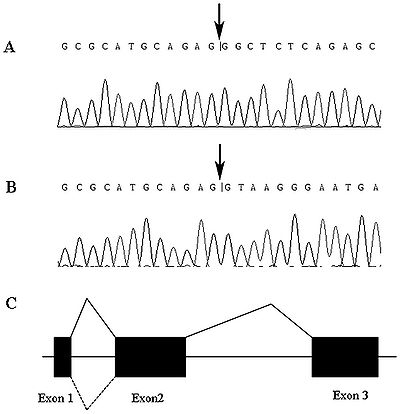Difference between revisions of "HCCAT5"
(→Characteristics) |
|||
| (2 intermediate revisions by one other user not shown) | |||
| Line 2: | Line 2: | ||
===Approved Symbol=== | ===Approved Symbol=== | ||
HCCAT5 | HCCAT5 | ||
| + | [[File: HCCAT5.jpg|right|thumb|400px|'''Alternative splicing of the HCCAT5 gene''' <ref name="ref2" />.]] | ||
===Approved Name=== | ===Approved Name=== | ||
hepatocellular carcinoma associated transcript 5 (non-protein coding) | hepatocellular carcinoma associated transcript 5 (non-protein coding) | ||
===Synonyms=== | ===Synonyms=== | ||
| − | HTA | + | FJ222407, "hepatoma associated gene", HTA |
===Chromosome=== | ===Chromosome=== | ||
16q22.3 | 16q22.3 | ||
| − | |||
| − | |||
| − | |||
| − | |||
===Ensembl ID=== | ===Ensembl ID=== | ||
ENSG00000260880 | ENSG00000260880 | ||
===pubmed IDs=== | ===pubmed IDs=== | ||
20130911, 23314567 | 20130911, 23314567 | ||
| − | + | ===OMIM ID=== | |
| + | 615613 | ||
===Diseases=== | ===Diseases=== | ||
* Hepatocellular carcinoma | * Hepatocellular carcinoma | ||
===Characteristics=== | ===Characteristics=== | ||
| − | + | HCCAT5 gene encodes a protein of 92 amino acids with an estimated molecular weight of 10.2 kDa.<ref name="ref2" /> | |
| − | |||
===Functions=== | ===Functions=== | ||
| − | + | HCCAT5 could play important roles in Hepatocellular carcinoma(HCC) development and progression and can be a promising molecular target for the development of new diagnostic and therapeutic strategies for HCC.<ref name="ref1" /> | |
| − | Overexpression of the | + | Overexpression of the HCCAT5 gene in the hepatic cell line QSG-7701 via stable transfection can promote its proliferation rate and colony forming ability and change the cell cycle distribution of the cell lines.<ref name="ref2" /> |
===Expression=== | ===Expression=== | ||
| − | The primer designed for | + | The primer designed for HCCAT5 is described as the following: HCCAT5 of 607 bp, 5-GGCTTACACATGCTCTTGCT-3, (sense) and 5-GCCGAGTTCACTCATCCTTCT-3 (antisense);<ref name="ref1" /> |
| − | + | HCCAT5 is highly expressed in hepatocellular carcinoma line HepG2, but is not detected in other cell lines.<ref name="ref1" /> | |
| − | |||
===Sequence=== | ===Sequence=== | ||
Latest revision as of 07:35, 19 September 2016
Contents
Annotated Information
Approved Symbol
HCCAT5

Approved Name
hepatocellular carcinoma associated transcript 5 (non-protein coding)
Synonyms
FJ222407, "hepatoma associated gene", HTA
Chromosome
16q22.3
Ensembl ID
ENSG00000260880
pubmed IDs
20130911, 23314567
OMIM ID
615613
Diseases
- Hepatocellular carcinoma
Characteristics
HCCAT5 gene encodes a protein of 92 amino acids with an estimated molecular weight of 10.2 kDa.[1]
Functions
HCCAT5 could play important roles in Hepatocellular carcinoma(HCC) development and progression and can be a promising molecular target for the development of new diagnostic and therapeutic strategies for HCC.[2]
Overexpression of the HCCAT5 gene in the hepatic cell line QSG-7701 via stable transfection can promote its proliferation rate and colony forming ability and change the cell cycle distribution of the cell lines.[1]
Expression
The primer designed for HCCAT5 is described as the following: HCCAT5 of 607 bp, 5-GGCTTACACATGCTCTTGCT-3, (sense) and 5-GCCGAGTTCACTCATCCTTCT-3 (antisense);[2] HCCAT5 is highly expressed in hepatocellular carcinoma line HepG2, but is not detected in other cell lines.[2]
Sequence
>gi|238859661|ref|NR_027756.1| Homo sapiens hepatocellular carcinoma associated transcript 5 (non-protein coding) (HCCAT5), long non-coding RNA
000081 CTGAAAGGAG CCTGTCAGCA GGAAGTGACC TCGTGAGACA ACTGTGGGGA GAGCAAAGGG CCGGGGAGAG AAAGGCCTCA 000160
000161 TTCTCACTGC AAACAGGAAA AGGAAAGAGA AAAAGCAAGC TCTGTCTCCA CACAAGGTTT GCTGGGCTGG CTATGAACTG 000240
000241 TTCCAGTACG TTCCATCAAA TAGACGCCTT CATAGAATCA AGCCGAGCGC GAACGCCGTG TCTGGGGCTC CCACTCCCGG 000320
000321 GACACACACG CGGGCTGGCT TACACATGCT CTTGCTCTCT CGCGCTCTGG GAGAGCGCTT ATATGGGCTT CATGAGGCTA 000400
000401 AGTAATAAAC ACTTTGTCTT CACCCTGCTA TTTATGGGTT GCTTGGGGCA TCCTGTGCTC TCCACTGCCC TTACCTGAAC 000480
000481 AGACGGCTCA TGCAGACCCG GAGTTTAATA GGGACAACAG TAAATCTGAG AGGCTGTGTG TGTCCCACGC GCTCCTGTTT 000560
000561 TCCCAGCCAC CCATGCTAGT TGCAGAGAAA AGCCAACCTG TATCCCTTCG TTTATGCTCT GTGTGCCCTT CCTGGAGAGA 000640
000641 TCCCTTCATT CTTCAGCAAT GGATCAAAGA ACTCTGAAAA CAAGAACAAC CCCGACAGCT GCAAACCACG AGCCCTCACC 000720
000721 TCCAGCAGAG GTTTTCGGGA AACTCTGGAC GACCACGCGC ATGCAGAGGG CTCTCAGAGC TTCCAGGTCC TGTAAGAAGA 000800
000801 GATGGAGTCA TAGCTGCGCC CTGTCCACTC TCGGGCTGTC ACACAAGCCT GGAGCCCAGC CATTTCTCGG CCTTGTCTTC 000880
000881 ATCTTGGGCT AACCGGTCGT CTCCTGCAAA CAGACAGCAC GGAGAAGGAT GAGTGAACTC GGCCTCTCCC CACAGAATAC 000960
000961 AGTTCGCCAT TACAGCGCTG ATTAAATACA GGACATTATC TCACCATAAT GCCCTCCTGG CGGCGTTCCC AGGAAAATTC 001040
001041 TAACTAATCA TAAAAATAGA AAGAAAAACG CAACCTAAAA AAAAAAAAAA AAAAAAAAAA AAAAAAAAAA AAAA
Labs working on this lncRNA
- Tumor Immunobiology Laboratory of Cancer Research Institute,Central South University, 410078 Changsha, Hunan, China [2].
- Tumor Immunobiology Laboratory of Cancer Research Institute,Central South University, 110 Xiangya Road, Changsha, Hunan 410078.[1]
References
- ↑ 1.0 1.1 1.2 1.3 Liu, Y., Y. Zhao, Q. Ju, L. Chen, F. Li, G. Zhou, P. Xie, G. Li, and Y. Li. "Molecular Clone and Functional Study of a Novel Hepatoma Associated Gene." Int J Oncol 42, no. 3 (2013): 1105-12.
- ↑ 2.0 2.1 2.2 2.3 Yan L,Y. L, Fj.G, Miao Dai, Jj.Wang, Jinyue.Hu and Guancheng Li.(2010) Identification of HTA as a novel-specific marker for human hepatocellular carcinoma.J Cancer Res Clin Oncol,136:1187–1192.